Intel Xeon E Six-Core Review: E-2186G, E-2176G, E-2146G, and E-2136 Tested
by Ian Cutress on November 5, 2018 12:00 PM EST- Posted in
- CPUs
- Intel
- Xeon
- Enterprise CPUs
- Xeon E
Gaming: Grand Theft Auto V
The highly anticipated iteration of the Grand Theft Auto franchise hit the shelves on April 14th 2015, with both AMD and NVIDIA in tow to help optimize the title. GTA doesn’t provide graphical presets, but opens up the options to users and extends the boundaries by pushing even the hardest systems to the limit using Rockstar’s Advanced Game Engine under DirectX 11. Whether the user is flying high in the mountains with long draw distances or dealing with assorted trash in the city, when cranked up to maximum it creates stunning visuals but hard work for both the CPU and the GPU.
For our test we have scripted a version of the in-game benchmark. The in-game benchmark consists of five scenarios: four short panning shots with varying lighting and weather effects, and a fifth action sequence that lasts around 90 seconds. We use only the final part of the benchmark, which combines a flight scene in a jet followed by an inner city drive-by through several intersections followed by ramming a tanker that explodes, causing other cars to explode as well. This is a mix of distance rendering followed by a detailed near-rendering action sequence, and the title thankfully spits out frame time data.
| AnandTech CPU Gaming 2019 Game List | ||||||||
| Game | Genre | Release Date | API | IGP | Low | Med | High | |
| Grand Theft Auto V | Open World | Apr 2015 |
DX11 | 720p Low |
1080p High |
1440p Very High |
4K Ultra |
|
There are no presets for the graphics options on GTA, allowing the user to adjust options such as population density and distance scaling on sliders, but others such as texture/shadow/shader/water quality from Low to Very High. Other options include MSAA, soft shadows, post effects, shadow resolution and extended draw distance options. There is a handy option at the top which shows how much video memory the options are expected to consume, with obvious repercussions if a user requests more video memory than is present on the card (although there’s no obvious indication if you have a low end GPU with lots of GPU memory, like an R7 240 4GB).
All of our benchmark results can also be found in our benchmark engine, Bench.
| Game | IGP | Low | Medium | High |
| Average FPS | 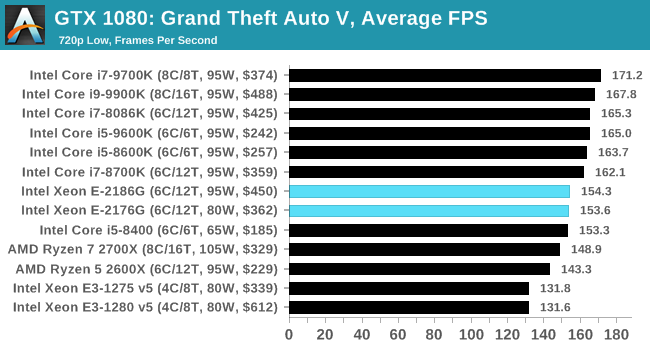 |
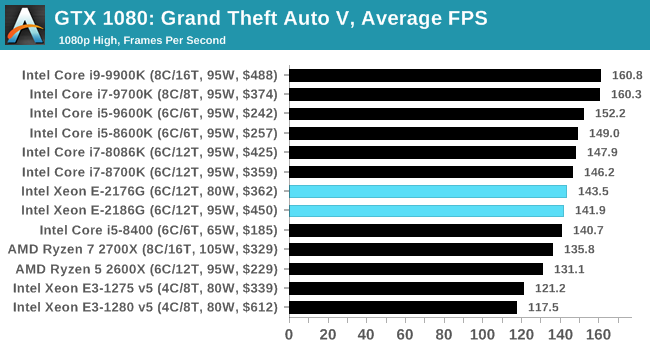 |
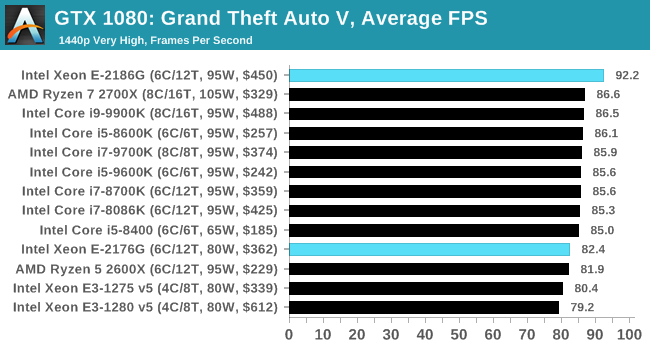 |
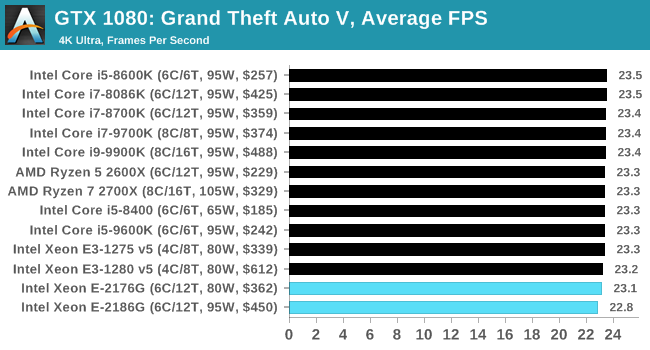 |
| 95th Percentile | 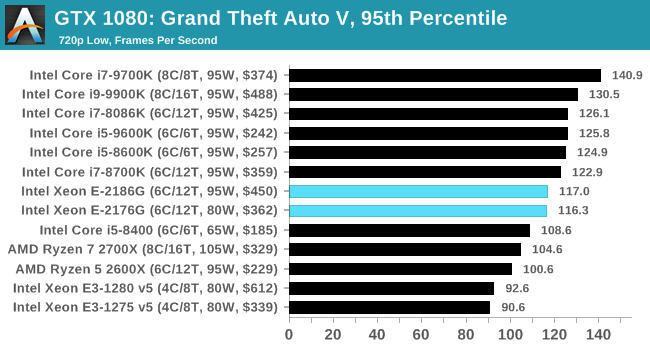 |
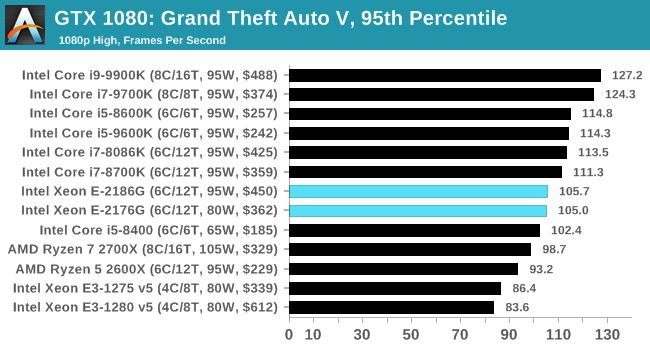 |
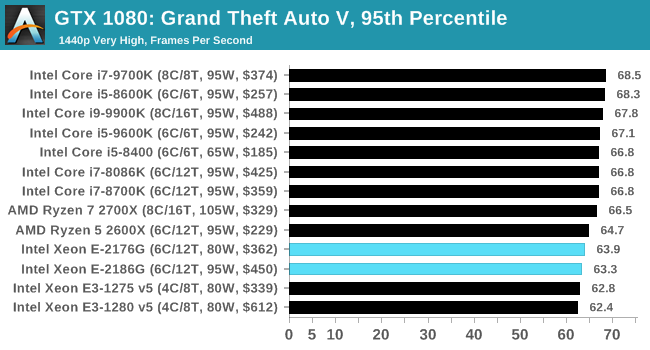 |
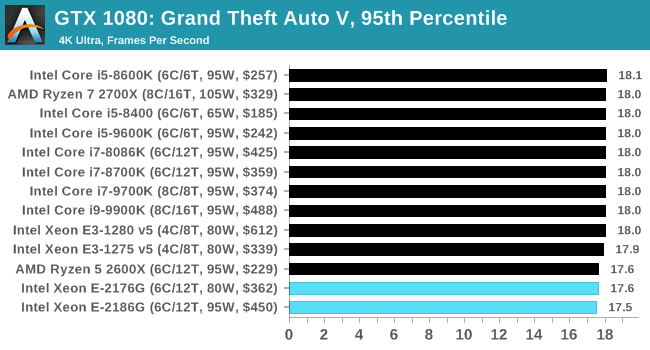 |












48 Comments
View All Comments
unsleepable - Thursday, November 8, 2018 - link
Any word on the lower-power members of the family? I imagine Intel will still release equivalents to previous generation processors like the Xeon E3-1260L v5, or counterparts to the i7 T CPUs like the Core i7-8700T, right?Chaitan - Saturday, November 10, 2018 - link
There is an interesting statement for these CPUs on ark: "Support for up to 128GB system memory capacity will be available in 2019 through a published BIOS Update. Please contact your hardware provider for availability and support."Does it mean that these will be the first mainstream CPUs with officially provided microcode for Intel memory controller to support 128GB?
Laptops with 128GB RAM support were announced several months ago by Dell, Lenovo and MSI (the latter with desktop CPUs and C246 chipset), but so far CPUs and BIOS for these laptops require custom OEM-specific CPU microcode for memory controller to really support such capacity.
Madao - Saturday, November 10, 2018 - link
I got lucky; got a 2176G on my doorstep from Provantage like Oct 20 for $330. X11SCA-W was in stock on newegg at the same time. I wanted the cheaper ASUS board but it was in stock nowhere.Really pisses me off that AMD and mobo makers dropped the ball on ECC. It should be standard in all computers and even phones. It only needs a few extra ram traces ffs --;
rannyjohns - Thursday, November 15, 2018 - link
I love your blog. And I always find something new here that I either hadn’t seen before or somehow managed to pass over. Thank you for this post! I am recently hoping to reach out and build my network in order to have more of a true collaboration going on, try more solution withasgehrj - Friday, December 14, 2018 - link
I'm not sure I agree that the only reason to get the top model is bragging rights.Agreed, turbo speed is very close to the lower end models, but:
It can sustain a 15% faster base clock than the lower end models, which is meaningful in e.g. render time. (It would almost equal an imaginary 7 core 2136)
"So buy a cpu with more cores" I hear you say...
True in most cases, but I'm building a 3D workstation, where the CAD application likes high single core clock speed , which is hard to find in the models with even more cores. The same machine also does the rendering, so in this case I'm pretty sure the 2186G (or the ..76G) is the better choice.